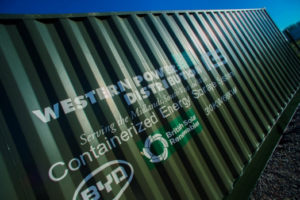
Network operator Western Power Distribution says interest in connecting storage assets, chiefly batteries, has reached “unprecedented levels”. It has agreed connections for more than 1GW of storage, with connection offers also made for a further gigawatt.
The company now seeks views from firms mulling energy storage investments so it can plan how to accommodate them on its networks across the midlands, south Wales and the south west.
WPD’s consultation aims to determine:
• The potential scale of growth of energy storage within its distribution network
• The type of energy storage assets/projects that are likely to be deployed within its network and their business models
• The typical operating behaviour of storage assets, how they are likely to be used and their typical modes of operation.
“WPD has received unprecedented interest in connecting storage assets. The volume of grid connection applications has significantly increased over recent years … A total of 2,354 MVA (across 139 sites) of connected, accepted and offered storage capacity is on our network,” states the consultation.

WPD said the volume of those connections in megawatt terms was broadly similar to the MVA value, but was dependent upon the tasks performed by the batteries. Applying a power factor unity of 0.95 to the MVA value would equate to some 2.2GW, the firm suggested.
To plan for the future, the DNO now seeks views on how the storage market might play out.
WPD said it will begin its modelling on a high growth scenario of 10-12 GW and 24-44 GWh of energy storage capacity installed across Great Britain by 2030. Its low growth scenario is 4-5 GW and 6-15 GWh. Both figures include 2.7GW of existing pumped storage.
Under its high growth scenarios, WPD moots grid services (frequency response) and the first wave of industrial and commercial applications for behind the meter models and co-location taking off between now and 2020.
From the early 2020s, those scenarios suggest rapid growth for commercial and industrial applications with co-location projects for wind and solar becoming viable and an expanding community and domestic market.
In the mid to late 2020s, this could be followed by new business models, arbitrage platforms, widespread domestic storage and co-location at wind/solar plants as well as integration of heat and electricity storage.
The consultation asks whether respondents agree with those scenarios, as well as its definition of market segments and services as well as more technical questions around discharge and operating modes and profiles.
Meanwhile, for those looking to progress projects in the near-term, WPD has launched a network capacity map to help developers understand its ability to accommodate larger scale projects by location.
See the consultation here.
Related articles:
Demand-side response and battery storage: Give us your views
As solar subsidies wane, investors plan 2.3GW of battery storage projects
As solar generation makes history, National Grid starts to feel the burn
UK Power Networks receives 12GW of storage applications
WPD launches DSR aggregator business
Government sets out smart grid vision
Limejump and Anesco partner to connect 185MW of capacity market battery storage
Centrica: Floodgates to open on storage in 2017
Vattenfall to build 22MW battery storage plant at south Wales windfarm
National Grid awards £66m of battery storage contracts
VLC Energy to connect 50MW of battery storage in 2017 after EFR contract win
Greg Clark calls for carmakers and energy firms to deliver battery storage
National Grid mulls rolling all frequency balancing services into one scheme
More than half of I&C firms mulling energy storage investment
Capacity market too low for large gas, but gigawatts of DSR, batteries and CHP win contracts
Battery storage: positive outlook?
National Grid must provide a plan for battery market, says SmartestEnergy
Who needs an EFR contract? Somerset solar site installs ‘grid scale’ Tesla battery
Ofgem: Energy flexibility will become more valuable than energy efficiency
National Grid says UK will miss 2020 targets, predicts big battery future
Follow us at @EnergystMedia. For regular bulletins, sign up for the free newsletter.



